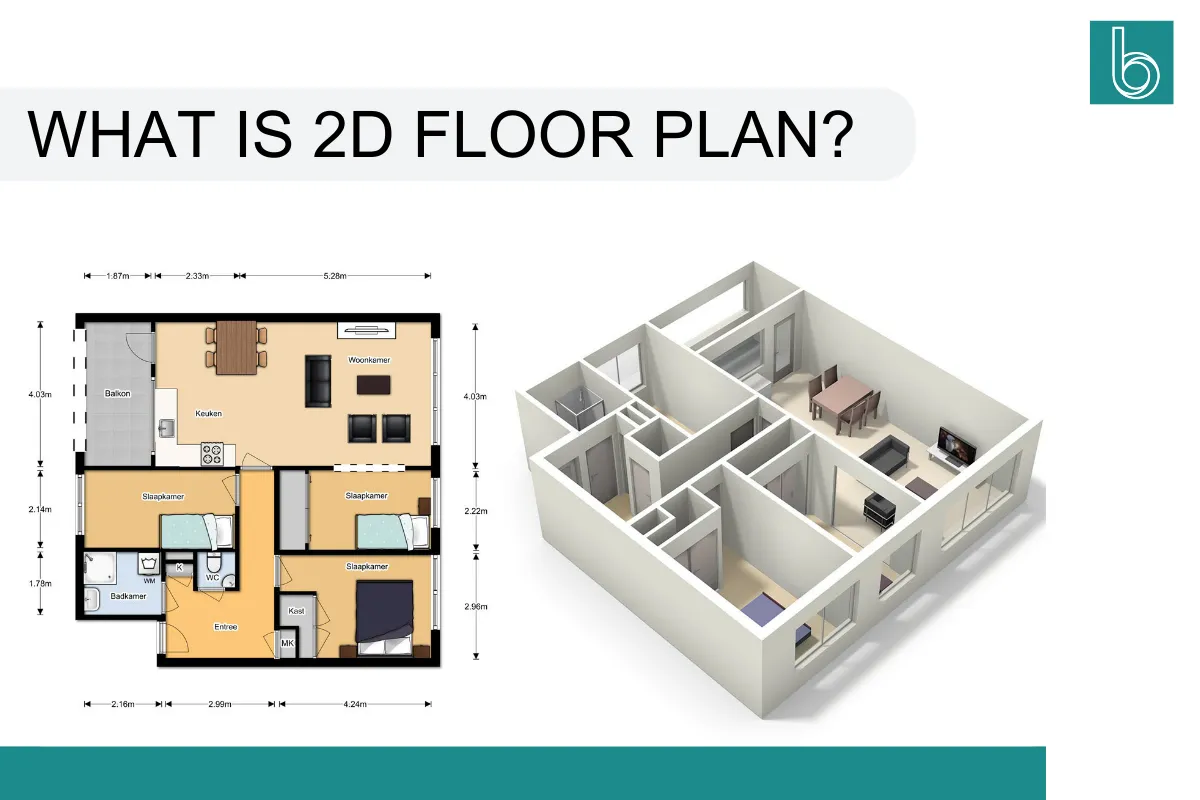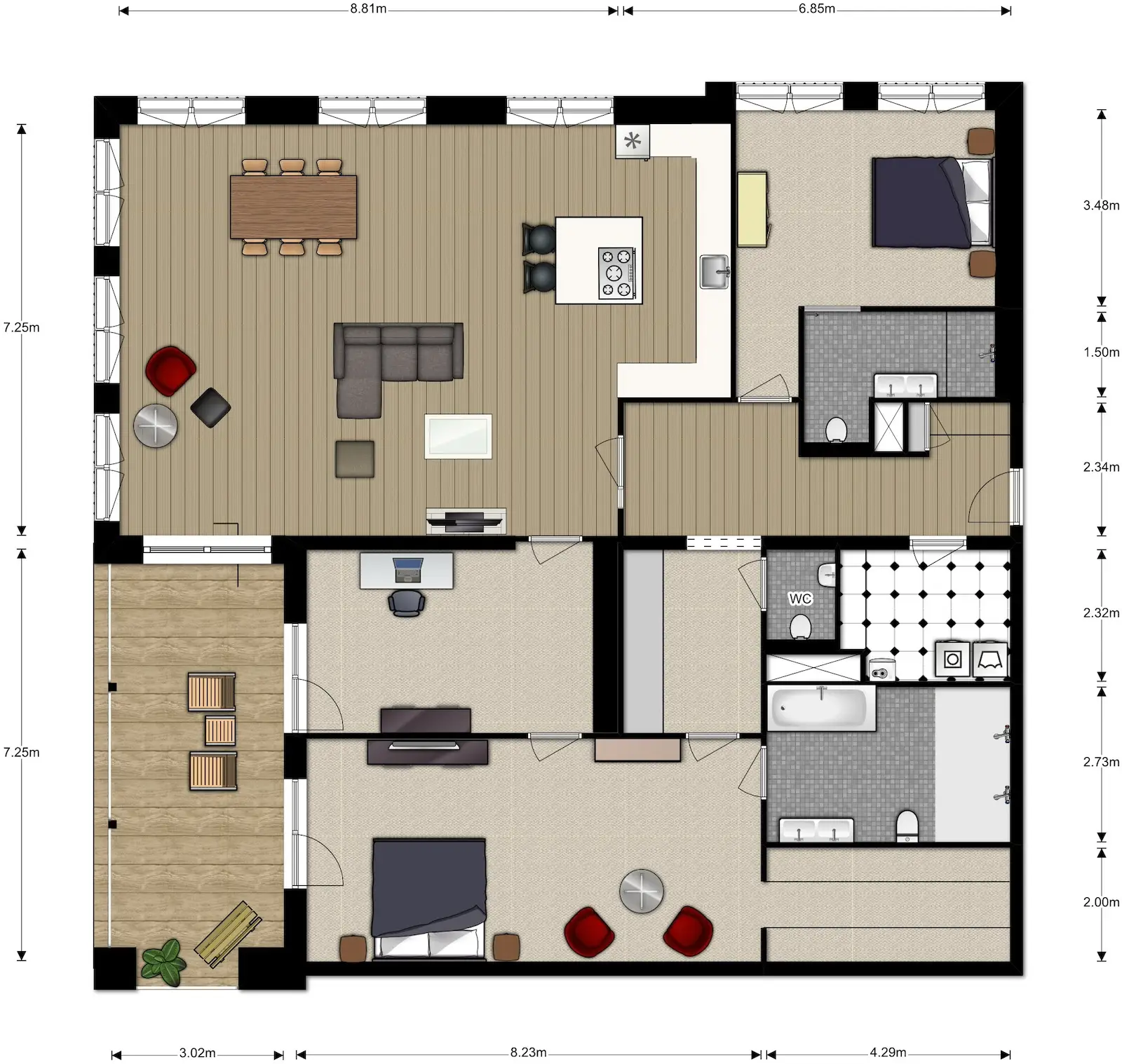
In this blog, we’ll dive into the details of 2D floor plans and why they’re so important in architecture, interior design, and real estate.
2D floor plans are detailed diagrams showing the layout of a property or space. They give an aerial view, helping us understand how rooms, walls, windows, and doors are arranged.
These plans are crucial in architecture because they help visualize designs, save space, and communicate well with you. In interior design, they assist in arranging furniture and planning space efficiently.
In real estate, 2D floor plans are key for marketing properties and helping you make informed decisions.
Whether you’re an expert in these fields or just curious, stay with us as we explore what is a 2D floor plan and how 2D floor plans are created, used, and benefit different industries. Let’s get started.
Key Takeaways
2D-floor plans are like detailed maps showing the layout of rooms, walls, doors, and windows in a home or building from a top-down view. They help us understand how everything fits together, including measurements, furniture placement, and utility locations like outlets and plumbing fixtures.
These plans are essential for real estate to showcase properties, interior design to plan room layouts, renovations to understand changes needed, and construction to ensure accurate building. While 2D plans are straightforward and flat, 3D plans offer more detailed and realistic views but serve different purposes.
What are 2D floor plans?
2D-floor plans are specific diagrams that depict the layout of a property or a space. It illustrates the positioning of the walls, rooms, and fixed installations such as; windows, doors, and stairs. 2D was originally stated as an image depicting flat surfaces that lack depth and perspectives.
Here are some key elements that every designer should read in the 2D floor plans;
- The compass mark
- Size and Measurements
- Window and door placement
- Ceiling beams
- Furniture placement
- Stairs
- Bedroom, Kitchen
- Electrical outlets
- Plumbing fixtures
How to create a 2D floor plan?
Whether you’re using paper and pencil or floor plan software to plan your floor, there are some basic steps and elements that you cannot afford to miss:
To create 2D floor plans:
- Outline the rooms: Start by drawing the room shapes using predefined options or by sketching with the pencil tool. Specify wall measurements and label each room for accuracy.
- Import existing plans: If you have physical floor plans, scan and import them into the software. Adjust the scale and trace over the outline digitally.
- Add windows and doors: Choose from the software’s catalog of windows and doors. Customize them by adjusting dimensions and opening directions to match your design.
- Include floors and stairs: For multi-story buildings, easily add floors with a click. Adjust floor heights and add stairs as required.
Additional Tips
Here are some additional tips for ensuring accuracy and clarity in 2D floor plan creation.
- Functionality: Arrange rooms so they’re convenient and serve their purpose well. Keep quiet areas like bedrooms away from noisy spaces like kitchens.
- Circulation: Ensure rooms and hallways are spacious for easy movement and fitting furniture comfortably.
- Customization: Design your home to match your interests and lifestyle. For example, make a big kitchen if you love cooking or add a gym if fitness is your thing.
- Future-Proofing: Think ahead about how your needs might change over time, like if your family grows or you start a home business.
- Practicality: Think practically about maintenance, heating bills, and cleaning before deciding on your final layout to avoid problems later on.
2D floor plans provide an aerial view of a property, illustrating key features like room layouts, walls, doors, windows, and stairs. They can be depicted with or without furniture, depending on your needs. These plans are basic and flat, without any angles or depth. Blinqlab’s 2D floor plans can be made for online viewing or printed in high quality.
Our 2D floor Plan Services will help you with your home or office redesign projects.
Types of 2D floor plans
Mainly, there are 3 types of 2D floor plans; standard solutions, black and white solutions, and colored solutions. Let’s take a look in detail.
Standard solutions
A standard solution in floor planning refers to a traditional layout that helps you understand a home’s structure. It demonstrates the layout of either the interior or the entire home.

These plans may include furniture or remain unfurnished and are commonly used for property listings, renovations, and remodeling.
Black and White solutions

DeLuxe floor plans
DeLuxe floor plans are customized 2D layouts of commercial or residential properties. By adding more interior decoration like plants, accessories and specific furniture, these plans become more intuitively appealing. In addition, instead of the default room colors, a variety of flooring details can be added.

Applications of 2D floor plans:
2D floor plans have a wide range of applications. From real estate, home, interior designing, and renovation to construction from scratch. Let’s elaborate each one of them in detail:
Application of 2D in real estate:
Having a floor plan is crucial for selling or renting out a property, as it enhances sales collateral significantly. A well-designed 2D layout plan is particularly important as it directly impacts the living experience within the property.
Even small deviations in the layout can affect how spacious or cramped a property feels. When deciding between a 2D and 3D floor plan, it’s important to consider the purpose: 2D plans are suitable for top-down or side views, while 3D plans allow for virtual walkthroughs.
While 3D building models may seem more modern and visually appealing, 2D plans are often seen as more professional and contribute to a smoother sales process.
Application in home and interior design
2D floor plans are useful for planning interior spaces before construction begins. They help decide where furniture should go with the surroundings and calculate available open spaces for circulation.
Using 2D floor plans helps prevent mistakes during execution and allows for adjustments based on furniture availability and placement.
Application in renovations
A 2D floor plan is crucial in renovation projects because it provides a clear overview of a property’s layout. This birds-eye-view layout showcases space usage, amenities, and furniture placement, including exterior features like gardens and garages. By using 2D-floor plans, you can gain an accurate understanding of the property’s dimensions and layout.
This makes it easier to visualize and make purchase decisions. These plans detail each floor individually which offers comprehensive insight into the property’s structure and layout. Ultimately, having a 2D floor plan ensures that you know exactly what you’re paying for and it facilitates smoother decision-making in renovation projects.
Application in construction
2D floor plans are essential tools in construction and architecture, as they offer an overview of a structure’s layout and individual spaces. They provide scale drawings of rooms, buildings, or bungalows that showcase relationships between spaces, furniture placement, and real-life measurements.
These plans serve as a vital communication medium between clients, builders, and architects as they convey technical information, precise measurements, and area specifications.
When created by professional design services, 2D-floor plans offer a simplified representation of a property’s layout, including room locations, walls, and stable installations like doors and windows.
Importance of 2D floor plans in architecture
2D floor plans are a crucial factor in the field of architecture and interior design. Additionally, its significance expands from architects, and real estate listings to brokers, remodelers, and so on. Let’s elaborate them each one of them in detail.
2D floor Plans for architects, home builders; 2D house plans architecture
Here are some key benefits of 2D Floor Plans for Architects, Home Builders; 2D House Plans Architecture:
- Visualization Aid: 2D-floor plans help architects and builders visualize architectural ideas and space arrangements effectively.
- Planning Assistance: It helps architects and designers in planning furniture placement and optimizing open spaces for circulation within a structure.
- Communication Tool: 2D-floor plans facilitate clear communication between you and housing professionals and ensure alignment on design specifications.
- Construction Guidance: 2D floor plans serve as a guide for seamless construction processes which helps workers in material ordering and referencing dimensions accurately.
- Error Reduction: Detailed dimensions and placement information in 2D floor plans help minimize on-site errors. It also reduces the need for costly last-minute changes.
- Client Satisfaction: 2D Floor Plans provide tangible proof of design concepts, allowing you to verify the final result against the initial plan thus ensuring satisfaction.
2D floor plans for real estate agents, remodelers, brokers, and realtors
Here are some key benefits of 2D Floor Plans for Real Estate Agents, Remodelers, Brokers, and Realtors:
- Visualization Aid: 2D-floor plans help real estate professionals showcase property layouts effectively to potential buyers or renters.
- Planning Assistance: It assists in planning furniture placement understanding property flow and enhancing presentations.
- Communication Tool: Clear and detailed 2D floor plans facilitate communication between you and real estate professionals. It helps ensure a mutual understanding of property layouts and features.
- Construction Guidance: Even though 2D-floor plans aren’t directly involved in construction, they provide insight into property features and layouts for prospective buyers or renters.
- Error Reduction: Accurate floor plans help prevent misunderstandings between property descriptions and actual layouts and eventually reduce customer dissatisfaction.
- Client Satisfaction: Providing comprehensive 2D-floor plans enhances the overall experience for you. It also helps in informed decision-making about property purchases or rentals.
2D floor plans for real estate listings
Here are some key benefits of 3D floor plans for 2D Floor Plans for Real Estate Listings:
- Visualization Aid: 2D-floor plans help present property layouts effectively in real estate listings and attract potential buyers or renters.
- Planning Assistance: It assists in understanding property flow and potential furniture placement, which allows the interested parties to envision themselves in the space.
- Communication Tool: Clear and detailed 2D floor plans facilitate communication between property sellers and potential buyers or renters which ensures mutual understanding of the property’s layout and features.
- Construction Guidance: 2D-floor plans provide insight into property features and layouts for interested parties.
- Error Reduction: Accurate floor plans help prevent misunderstandings between property descriptions and actual layouts which reduces dissatisfaction.
- Client Satisfaction: Providing comprehensive 2D-floor plans enhances the overall experience for potential buyers or renters, which helps in their decision-making process.
Comparing 2D vs 3D floor plans
When it comes to floor plans, there’s a clear distinction between 2D and 3D options. A 2D-floor plan provides a basic, flat representation of a property’s layout. It focuses solely on the arrangement of rooms, walls, and fixtures.
On the other hand, a 3D floor plan adds depth and dimension, offering a more detailed view with a realistic view of furniture, decor, and architectural features.
While 2D plans are more affordable and straightforward, 3D plans excel in quality, flexibility, and interactivity, and allow for immersive virtual tours and design modifications.
Therefore, the ultimate choice between 2D and 3D depends on your specific needs and the budget of the project.
Conclusion
Having a good understanding of 2D floor plans is vital for architects, designers, and real estate professionals. They help in realistic visualization of layouts, save space, and talk with you. This blog highlights its importance in architecture, design, real estate, and construction. I hope you gain valuable insights from this guide and use 2D floor plans to create a better space. Whether you’re fixing up a place, showing properties, or building, using 2D plans can make things easier and more attractive.
Explore our floor plan services
